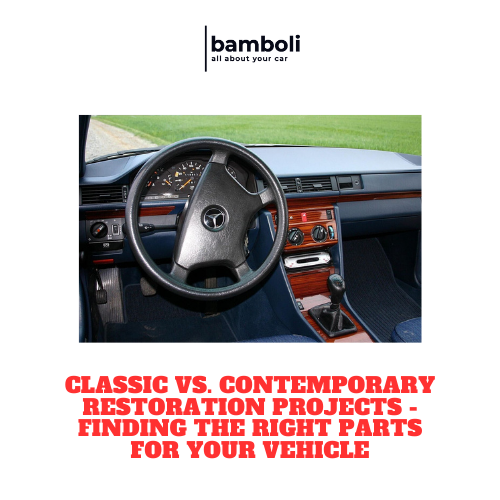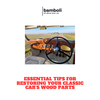Classic vs. Contemporary Restoration Projects - Finding the Right Parts for Your Vehicle

Restoring a classic or contemporary vehicle, finding the right parts can make all the difference in the outcome of your project. Whether you are working on a vintage car or a modern sports car, choosing the correct components is essential to ensure the authenticity and performance of your vehicle.
Main Points
- Classic vs. Contemporary Restoration Projects: Understand the differences between restoring a classic car and a contemporary vehicle.
- Finding the Right Parts: Learn the importance of sourcing authentic and high-quality components for your restoration project.
- Challenges and Solutions: Explore the common challenges faced when searching for parts and discover effective solutions to overcome them.
- Expert Advice: Seek guidance from professionals in the automotive restoration industry to ensure the success of your project.
Understanding the Differences Between Classic and Contemporary Restoration Projects
Restoration projects, there are two main categories that are often discussed: classic and contemporary. While both involve the process of restoring a building or structure to its former glory, there are key differences between the two that are important to understand.
Classic Restoration Projects
Classic restoration projects typically involve historic buildings or structures that have significant architectural or historical value. These projects aim to preserve the original design and materials of the building, while also ensuring that it meets modern safety and functionality standards. Some key characteristics of classic restoration projects include:
- Preservation: The primary goal of classic restoration projects is to preserve the original design and materials of the building.
- Historical Accuracy: Every effort is made to ensure that the restoration work is historically accurate and in line with the building's original construction.
- Conservation: Special care is taken to conserve and protect any historic elements of the building, such as original artwork, moldings, or architectural features.
Contemporary Restoration Projects
In contrast, contemporary restoration projects involve modern buildings or structures that may not have the same historical significance as classic projects. These projects focus on updating and improving the functionality and aesthetics of the building, often using more innovative and sustainable materials and techniques. Some key characteristics of contemporary restoration projects include:
- Modernization: The main goal of contemporary restoration projects is to modernize the building to meet current standards and trends.
- Sustainability: Contemporary restoration projects often incorporate eco-friendly and sustainable materials and practices to reduce environmental impact.
- Innovation: These projects may involve the use of new technologies or design concepts to enhance the building's overall appearance and functionality.
By understanding the differences between classic and contemporary restoration projects, you can better appreciate the unique challenges and approaches involved in each type of restoration work.
Sourcing Authentic Parts for Classic Restoration Projects
Restoring a classic car can be a labor of love for many enthusiasts. One of the key components of a successful restoration project is sourcing authentic parts that match the original specifications of the vehicle. Whether you are restoring a vintage Ford Mustang or a classic Chevrolet Bel Air, finding the right parts can make all the difference in the final result.
Researching Authentic Parts
When embarking on a classic restoration project, it is essential to do thorough research to ensure you are sourcing genuine parts. Start by consulting the vehicle's manual or reaching out to specialized suppliers who focus on classic car parts. Online forums and enthusiast groups can also be valuable resources for locating authentic parts.
Quality over Price
While it may be tempting to opt for cheaper alternatives, it is crucial to prioritize quality over price when sourcing parts for a classic restoration. Authentic parts may come with a higher price tag, but they are designed to fit your vehicle perfectly and maintain its original integrity. Investing in authentic parts will ensure the longevity and authenticity of your restoration project.
Establishing Relationships with Suppliers
Building relationships with reputable suppliers who specialize in classic car parts can be beneficial for sourcing authentic parts. Establishing a rapport with these suppliers can lead to access to rare or hard-to-find parts, as well as expert advice on restoration techniques. Suppliers who understand the importance of authenticity in classic car restoration projects can be valuable partners in your journey.
|
Benefits of Sourcing Authentic Parts |
Factors to Consider |
|
1. Originality: Authentic parts maintain the originality of the vehicle. |
1. Fitment: Ensure the parts fit your vehicle's make and model. |
|
2. Quality: Authentic parts are designed to meet the vehicle's specifications. |
2. Reputation: Choose suppliers with a proven track record of authenticity. |
|
3. Longevity: Authentic parts ensure the longevity of your restoration project. |
3. Pricing: While authentic parts may be more expensive, they offer long-term value. |
Utilizing Modern Technology in Contemporary Restoration Projects
In the field of architecture and restoration, the use of modern technology has revolutionized the way historical buildings and structures are preserved and restored. With the advancements in digital tools and techniques, architects and preservationists are now able to accurately document, analyze, and recreate intricate details of heritage sites with unprecedented precision.
The first important aspect of incorporating modern technology in restoration projects is the use of 3D scanning and modeling. This technology allows professionals to create detailed digital replicas of buildings, capturing every minute detail with incredible accuracy. By having a virtual model of the structure, architects can assess its condition, identify areas of deterioration, and plan restoration work more efficiently.
Furthermore, the use of drones in restoration projects has significantly improved the accessibility of hard-to-reach areas of historical buildings. Drones equipped with high-resolution cameras can capture aerial images of the structure, providing valuable data for analysis and documentation. This technology not only saves time and resources but also minimizes the risk of damage to the building during inspections.
The integration of Building Information Modeling (BIM) software has revolutionized the way restoration projects are planned and executed. BIM allows architects, engineers, and contractors to collaborate on a unified platform, facilitating better coordination and communication throughout the restoration process. With BIM, stakeholders can visualize the entire project in a virtual environment, making informed decisions and adjustments before any physical work begins.
In conclusion, modern technology has played a crucial role in enhancing the efficiency, accuracy, and sustainability of contemporary restoration projects. By embracing digital tools and techniques, architects and preservationists can ensure the preservation of our cultural heritage for future generations to appreciate and enjoy.
Restoration Challenges Faced in Classic Vehicle Projects
Restoring classic vehicles can be a rewarding but challenging task. Classic vehicles often come with a unique set of challenges that require careful planning and attention to detail.
Common restoration challenges faced in classic vehicle projects:
- Sourcing Parts: One of the biggest challenges in classic vehicle restoration is finding original or replacement parts for rare and discontinued models. This can be a time-consuming process that requires research and networking with other enthusiasts.
- Rust and Corrosion: Classic vehicles are prone to rust and corrosion, especially if they have been sitting unused for a long period of time. Removing rust and repairing corroded parts can be a labor-intensive task that requires specialized tools and expertise.
- Technical Expertise: Restoring a classic vehicle often requires a high level of technical expertise, especially when it comes to working on older engines and mechanical systems. Finding knowledgeable mechanics or enthusiasts who can assist with the restoration process is essential.
In addition to these challenges, budget constraints and time limitations can also impact the progress of a classic vehicle restoration project. However, with patience, perseverance, and a passion for preserving automotive history, overcoming these challenges is possible.
|
Challenge |
Description |
|
Sourcing Parts |
Finding original or replacement parts for rare and discontinued models |
|
Rust and Corrosion |
Dealing with rust and corrosion on classic vehicle components |
|
Technical Expertise |
Having the necessary skills and knowledge to work on older mechanical systems |
Exploring Customization Options in Contemporary Restoration Work
Restoration work today goes beyond simply restoring a building to its original state. With advancements in technology and design, there are now countless customization options available to make a restored building truly unique. Whether it's adding modern amenities, incorporating sustainable materials, or creating a one-of-a-kind architectural feature, the possibilities for customization are endless.
The Impact of Customization
Customization allows for a personalized touch to be added to a restoration project, making it stand out from the rest. By incorporating innovative design elements, the restored building can become a showcase of creativity and craftsmanship. This level of customization not only enhances the aesthetic appeal of the building but also increases its value in the eyes of potential buyers or tenants.
From choosing unique paint colors to installing custom lighting fixtures, each customization option helps to create a space that reflects the vision and personality of the owner. This attention to detail sets contemporary restoration work apart from traditional restoration methods and allows for a more dynamic and inclusive approach to preserving historic buildings.
Overall, exploring customization options in contemporary restoration work opens up a world of possibilities for creating truly exceptional spaces that blend the best of the past with the innovations of the present.
Cost Analysis: Budgeting for Classic vs. Contemporary Restoration Projects
Restoring a classic or contemporary property can be a rewarding but costly endeavor. Before embarking on a restoration project, it’s important to consider the budgeting differences between classic and contemporary properties.
Classic Restoration Projects
Restoring a classic property, such as a Victorian-era home or a historic building, often requires meticulous attention to detail and high-quality materials. The cost of restoring a classic property can be higher due to the need for specialized restoration techniques and materials that match the original design.
“Restoring a classic property is like preserving a piece of history for future generations to enjoy.”
When budgeting for a classic restoration project, it’s crucial to account for potential surprises such as hidden damage, deteriorated structural elements, or the need for custom-made architectural features.
Contemporary Restoration Projects
Restoring a contemporary property, such as a modernist home or a sleek commercial building, may come with its own set of challenges. While the overall cost of a contemporary restoration project can vary depending on the scope and complexity of the work, it is often more predictable than classic restoration projects.
Contemporary restoration projects may focus on updating mechanical systems, improving energy efficiency, or incorporating modern amenities. While the cost of materials for contemporary projects may be lower compared to classic projects, the labor costs for specialized tradespeople or cutting-edge technologies can add up.
Cost Comparison
|
Aspect |
Classic Restoration |
Contemporary Restoration |
|
Materials |
High-quality, specialized |
Modern, energy-efficient |
|
Labor |
Skilled craftsmen, restoration experts |
Specialized tradespeople, modern technologies |
|
Unforeseen Costs |
Hidden damage, custom features |
New technologies, updates |
Ultimately, the cost of a restoration project will depend on the unique characteristics of the property and the goals of the restoration. Whether restoring a classic or contemporary property, budgeting accurately and thoughtfully is essential to ensuring a successful outcome.
Preserving Authenticity: Balancing Tradition and Innovation in Vehicle Restoration
Restoring classic vehicles is a labor of love for many enthusiasts who are passionate about preserving automotive history. However, when it comes to vehicle restoration, striking a balance between honoring tradition and embracing innovation is crucial to maintaining authenticity.
The Importance of Preserving Authenticity
When restoring a vintage vehicle, it is essential to retain its original character and features. Authenticity ensures that the vehicle maintains its historical value and unique identity.
Striking a Balance between Tradition and Innovation
While it is important to stay true to the vehicle's original design and specifications, incorporating modern advancements can enhance its performance and reliability. Balance between tradition and innovation is key to creating a classic vehicle that is both timeless and functional.
Tips for Successful Vehicle Restoration
- Research: Before beginning a restoration project, conduct thorough research on the vehicle's history, specifications, and authentic parts.
- Consult Experts: Seek advice from experienced classic car restorers and specialists to ensure accuracy and authenticity.
- Document Progress: Keep detailed records of the restoration process, including photographs and notes, to track changes and maintain authenticity.
By following these tips and focusing on preserving authenticity while balancing tradition and innovation, vehicle enthusiasts can create stunning classic cars that honor the past while embracing the future.
Frequently Asked Questions
What are the main differences between classic and contemporary restoration projects?
Classic restoration projects focus on preserving the original design and features of a vehicle, while contemporary projects may involve modern upgrades and modifications for improved performance and functionality.
Where can I find authentic parts for classic car restoration?
Authentic parts for classic car restoration can be found through specialized vintage car part suppliers, online auctions, salvage yards, and classic car restoration forums.
What should I consider when choosing replacement parts for a contemporary restoration project?
When choosing replacement parts for a contemporary restoration project, consider compatibility with the vehicle model, quality of materials, reputation of the manufacturer, and warranty options.
Are there specific tools and equipment required for vehicle restoration projects?
Yes, vehicle restoration projects often require specialized tools and equipment such as sanders, welders, paint sprayers, engine hoists, and diagnostic tools for modern vehicles.
How can I stay organized and track progress during a restoration project?
To stay organized during a restoration project, create a detailed project plan, keep records of parts and expenses, use labeling and storage systems for parts, and document progress with photos and notes.
-
Posted in
Accessories, Advantages, Classic car tips & tricks, Classic Mercedes, Fabric, Horn, Installation, Interior




